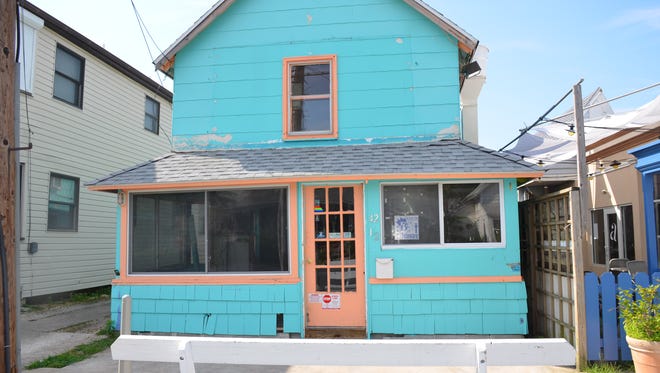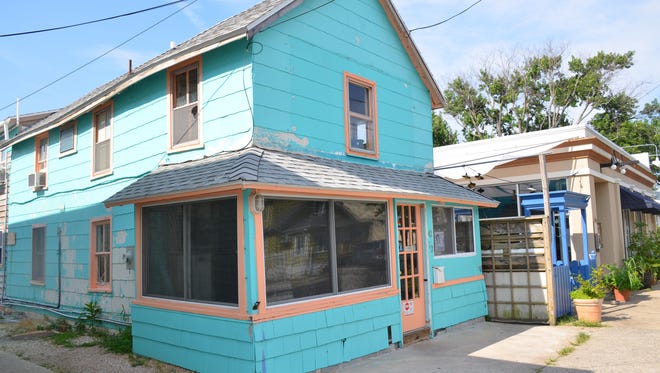Historic Rehoboth Camp building to be new restaurant

The origins of Rehoboth Beach can be traced to an 1800s religious "camp meeting" — a settlement that, at its peak, had hundreds of primitive dwellings to house the worshipping summertime visitors.
But the phenomenon was short lived and the Rehoboth Beach Camp Meeting was disbanded before the turn of the 19th century. After that, the area, growing in popularity as a resort destination, was briefly named "Henlopen City" before it reverted to Rehoboth Beach.
Today, very little remains of the original Methodist camp meeting as most of the structures were demolished or otherwise destroyed to make room for larger, more comfortable homes, cottages, businesses, streets and parks.
But there are, amazingly, several survivors of that era and one of them on Baltimore Avenue was recently acquired by the owners of the nearby Blue Moon restaurant, a well-regarded establishment that opened in 1981.
And, appropriately, Blue Moon also is in a historic dwelling that was originally a Sears, Roebuck mail order home.
The new owners of the former camp meeting structure say they are committed to preserving the remnants of the 1890 building's historic past.
"We are trying to keep it as original as possible and we believe the (renovation) plan does keep the integrity of the space," said Meghan Gardner, one of the Blue Moon co-owners.

That commitment brought praise from Nancy Alexander, director of the Rehoboth Beach Museum.
"I really applaud you," she told Gardner during a recent tour of the building.
Later, Alexander said the surviving Baltimore Avenue building is "one of the few remaining links" to the origins of Rehoboth Beach.
"The new owners are to be commended," she said.
The Blue Moon owners — Meghan and Lion Gardner, Tim Ragan, Randy Haney — bought the building with the intention of renovating the space for a new, fast casual restaurant called Axis.
Prior to their acquisition it had been a restaurant — the Seafood Shack.
The team hopes to have official Rehoboth Beach approval to begin renovation soon with the intention of having it open for business later this year.
"We already have everything in place, including the silverware," Meghan Gardner said.
Meghan Gardner said a visual inspection suggests that the original camp meeting structure has been expanded at least twice since the late 1800s. It also had some functional but unattractive blue siding installed at some point.
"We hope to get it looking more like it did originally," she said.
The historic building, a short distance from Blue Moon on the opposite side of Baltimore Avenue, is next door to another well-known local restaurant - a(MUSE.).
Alexander said the original camp meeting structures may have been tents that were gradually converted to more permanent wood houses. Even so, they did not have bathrooms or kitchens.
"They ate communally," Alexander said.
However, one common feature for most dwellings was its front porch, a frequent gathering place for camp meeting attendees.
"The front porch was very social," Alexander said.
At its peak in the 1800s, the Rehoboth camp meeting had well over 500 tent or wood dwellings, constructed with little space between them.
The camp was founded in 1873 by Rev. Robert Todd, pastor of St. Paul's Methodist Episcopal Church in Wilmington. The church was able to purchase 400 acres of land for its camp meeting in Rehoboth at a cost of $15,000.
As it developed, Todd's camp meeting in Rehoboth also had an open air tabernacle for worship, located near where Grove Park is now, at the intersection of Columbia Avenue and Grove Street.
Though most of the original camp meeting homes have either been torn down or renovated extensively, a significant number of dwellings on Baltimore Avenue also vanished during several major blazes in the 1900s.
"Baltimore Avenue was the site of two spectacular fires," said Alexander.
And, pointing to the structure acquired by the Blue Moon partners, she said, "It is amazing that this building even survived."

While fewer than 20 of the original camp meeting structures survived fires or demolition, one of them was the Anna Hazzard house, which was built in 1895.
According to the Rehoboth Beach Historical Society, the home eventually was converted to a rental property by owner W. Harry White, who also added a kitchen to improve its appeal. White gave the property to his niece, Anna Hazzard, in 1927.
Hazzard's heirs donated the house to the historical society in 1975 with the understanding that it would be moved.
The society moved it from Baltimore Avenue to its present location on Christian Street, where it functions as a museum — and a visual testament to the early history of Rehoboth Beach.
It has two rooms and a porch on ground level and a pair of bedrooms on the second floor.
In addition to Rehoboth Beach, southern Delaware also had another camp meeting — in Clarksville, near Dagsboro.
Unlike the Rehoboth camp meeting, the Union Wesley Methodist Episcopal Church complex is still active. However, many of the original, primitive dwellings have been replaced by recreational vehicles for use during the week-long summer gathering in late July or early August.
In Rehoboth Beach, the museum has a display devoted to the camp meetings of the late 1800s. The Rehoboth Beach Museum is located at 511 Rehoboth Avenue and is open daily in the summertime.
The camp meeting "is an important part of our history," Alexander said.
raetyson@gmail.com